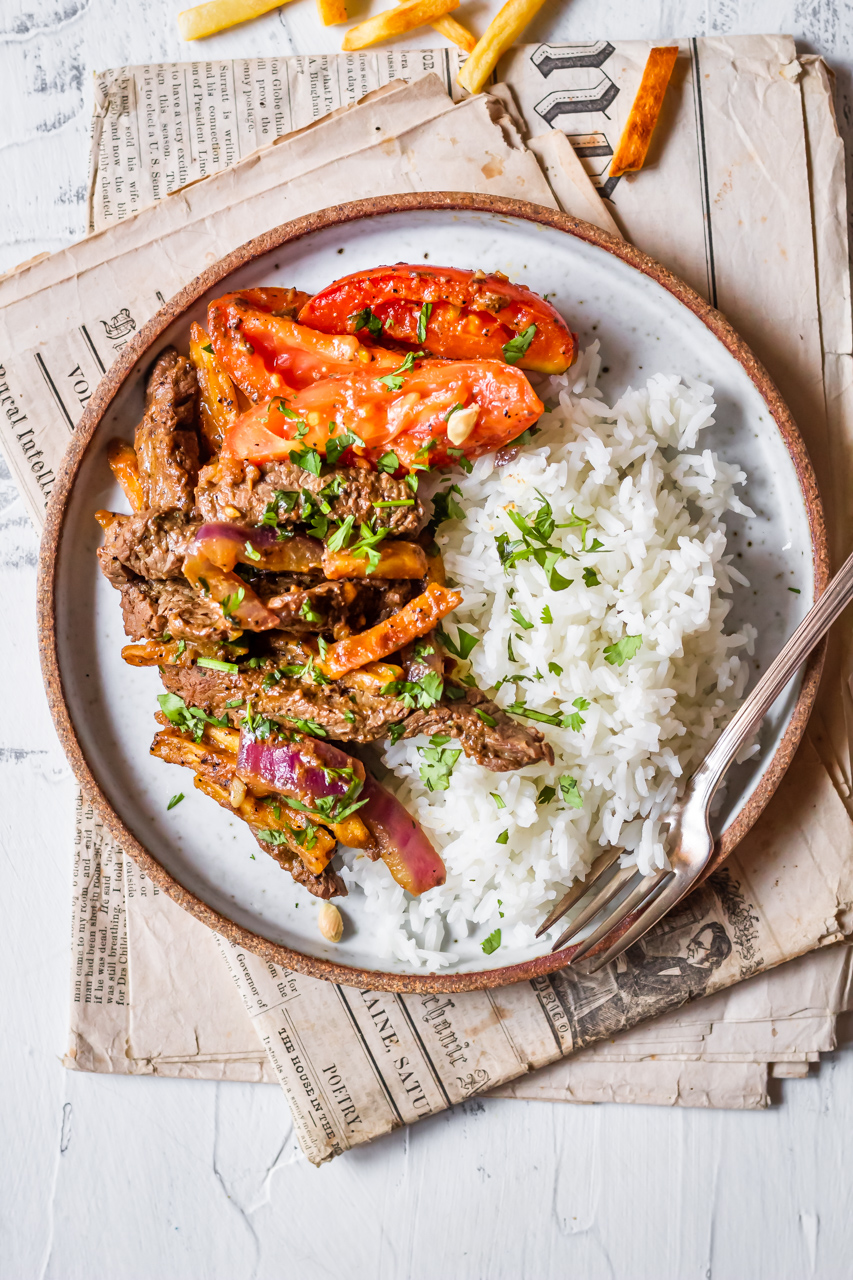Exploring the rich and diverse world of Latin food opens up a vibrant array of flavors and cooking traditions. From savory dishes like empanadas to sweet treats like churros, Latin American cuisine offers something to satisfy every palate.
This article will guide you through 25 delectable recipes that highlight the unique ingredients and techniques of various Latin American countries. Whether you are an experienced chef or a home cook, you will find these recipes accessible and rewarding to make.
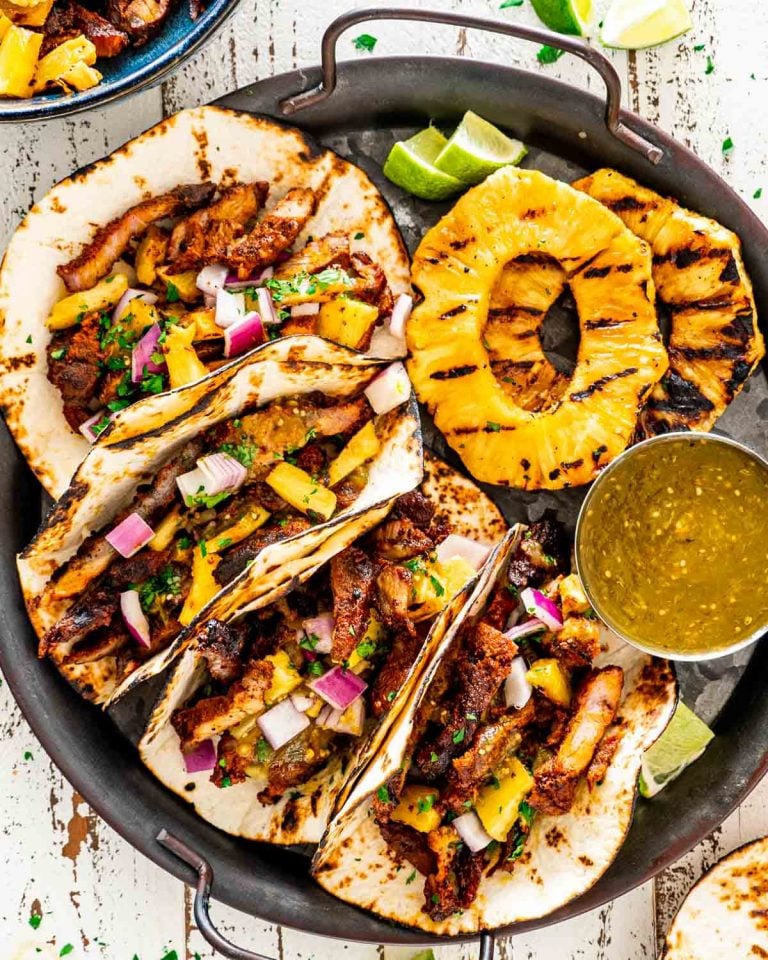
1) Tacos al Pastor
Tacos al Pastor is a beloved Mexican dish that combines marinated pork with pineapple for a delicious flavor.
You start by preparing the marinade. Blend peppers, achiote, vinegar, pineapple juice, garlic, oregano, cumin, black pepper, whole cloves, and salt. Strain the sauce for a smooth texture.
Next, season pork with salt and pepper and marinate it in the sauce. Let it sit for at least a few hours or overnight for the best flavor.
When you’re ready to cook, preheat your oven to 325 degrees F. Brown the pork in a hot skillet or Dutch oven. If needed, work in batches.
After browning the meat, you can roast it in the oven until fully cooked. This method gives it a tender and juicy texture.
For an authentic touch, serve the pork with pieces of pineapple on warm corn tortillas. Top with fresh cilantro, diced onions, and a squeeze of lime.
Reheating leftovers is easy. For small servings, use a microwave. For larger portions, heat in a skillet with a splash of water.
Enjoy this iconic Latin dish that perfectly balances savory and sweet flavors!
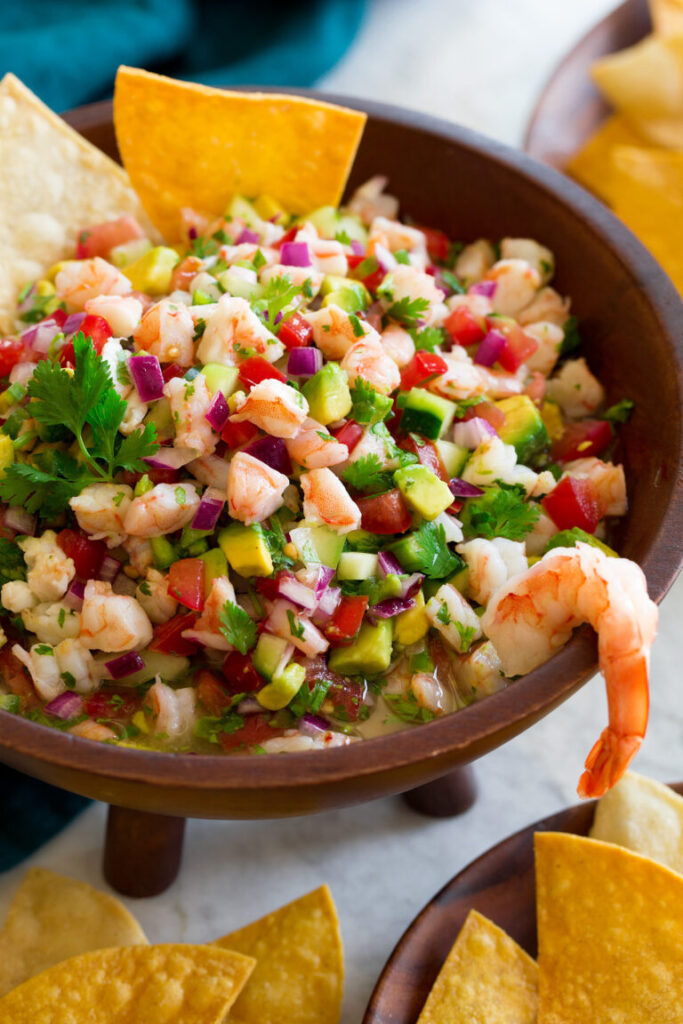
2) Ceviche
Ceviche is a classic Latin American dish that you’ll love for its fresh flavors. It’s made by marinating raw fish or shrimp in citrus juice, usually lime or lemon. The acid from the citrus “cooks” the seafood without heat, making it safe to eat.
To prepare ceviche, start by dicing your choice of seafood, such as white fish or shrimp. Make sure the pieces are small and even to ensure they marinate quickly. Cover the seafood with fresh lime juice and let it rest in the refrigerator until the seafood turns opaque.
Next, add finely chopped vegetables like tomatoes, onions, cucumbers, and jalapeños. These veggies add crunch and vibrant flavor to the dish. For extra zest, mix in some chopped cilantro and a pinch of salt.
For an added touch, you may also include ingredients like olives, green chiles, or a splash of orange juice. These can enhance the complexity of your ceviche. Serve it cold, often with tortilla chips or on tostadas, for a refreshing and delicious appetizer.
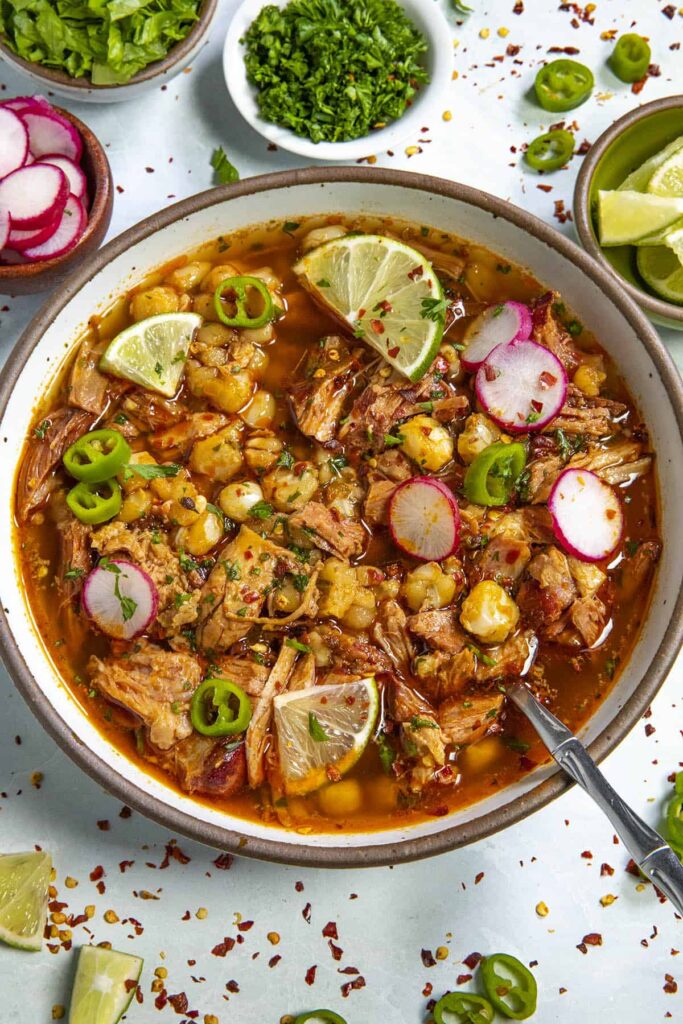
3) Pozole
Pozole is a traditional Mexican soup made with hominy, pork, and a flavorful red chile broth. This dish has deep roots in Mexican culture and is often enjoyed during celebrations and family gatherings.
You start by cooking pork with onion, garlic, salt, bay leaves, and oregano. This mixture simmers until the pork is tender and has absorbed the aromatic spices.
Next, hominy is added to the pot. Hominy is dried corn that’s been soaked and treated to remove the hull and germ. It adds a unique texture and flavor to the soup.
To make the red chile broth, you blend softened guajillo chiles until smooth. Strain the mixture to remove any remaining pulp. Then, sauté the chile base in oil for added depth of flavor.
Combining the pork, hominy, and chile broth creates a rich, savory Pozole. Serve it hot, garnished with shredded lettuce, radishes, lime wedges, and tortilla chips for that authentic touch.
Enjoy this warm, comforting dish with friends and family, and experience a piece of Mexican culinary tradition.
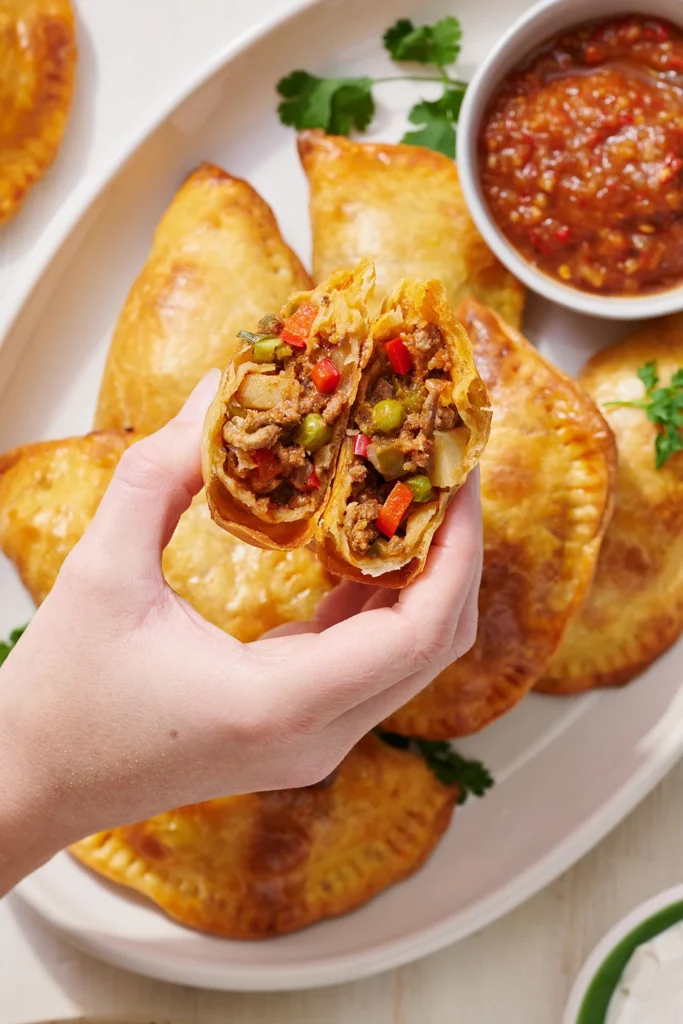
4) Empanadas
Empanadas are a popular Latin American dish. They are essentially pastries filled with various ingredients. You can bake or fry them, depending on your preference.
To make empanadas, start with a simple dough. Use a round cutter to make circles from the dough. For the filling, ground beef is a common choice. Brown the beef in a skillet over medium-high heat.
Once the beef is cooked, add seasonings like garlic salt, pepper, and tomatoes. Some recipes also include diced potatoes. Let the mixture cook until the potatoes are tender.
Next, place a spoonful of the beef filling in the center of each dough circle. Fold the dough over to form a half-moon shape. Secure the edges by pressing them with a fork.
If you choose to bake the empanadas, brush them with a beaten egg for a shiny finish. Bake them at 350 degrees for around 25-30 minutes until golden brown. Frying is another option. Heat oil to about 350 degrees and fry each empanada for 3-5 minutes.
Serve your empanadas with salsa, lettuce, pico de gallo, or crema. Enjoy the rich flavors and satisfying texture.
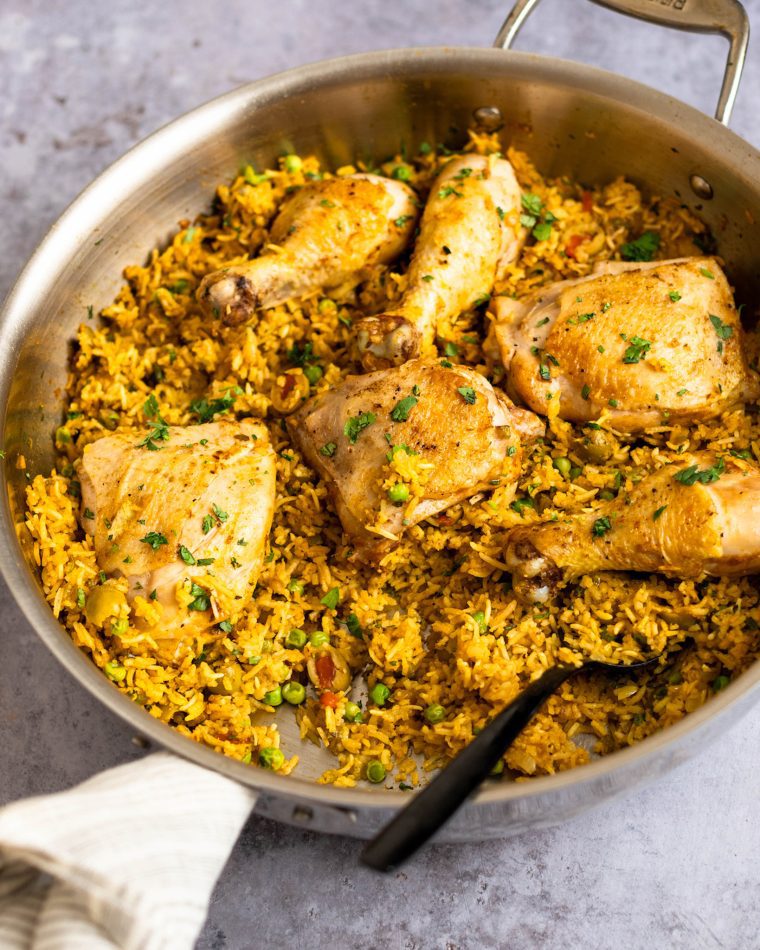
5) Arroz con Pollo
Arroz con Pollo is a beloved Latin American dish made with chicken and rice. Each country has its own twist on the recipe, giving it unique flavors.
Start by browning chicken pieces in a large skillet. This helps to lock in the juices and adds a rich flavor to the dish. Remove the chicken and set it aside.
Next, sauté onions and bell peppers in the same skillet until they become soft and fragrant. Add garlic and green onions, cooking briefly.
Now, add the rice to the skillet. Toast it for a few minutes, stirring constantly. This step adds a nice, nutty flavor to the rice.
Pour in chicken broth and tomato sauce to mix with the rice. Return the chicken to the skillet, ensuring it’s well-coated with the mixture.
Cook until the rice is tender and the chicken is fully cooked. Make sure to stir occasionally to prevent sticking.
Different variations might include adding carrots, peas, or olives for extra flavor and texture. Feel free to experiment with seasonings like cumin or oregano.
Arroz con Pollo is perfect for family dinners and gatherings. It’s a comforting, one-pot meal that everyone will love. Enjoy it with a side of fresh salad or fried plantains.
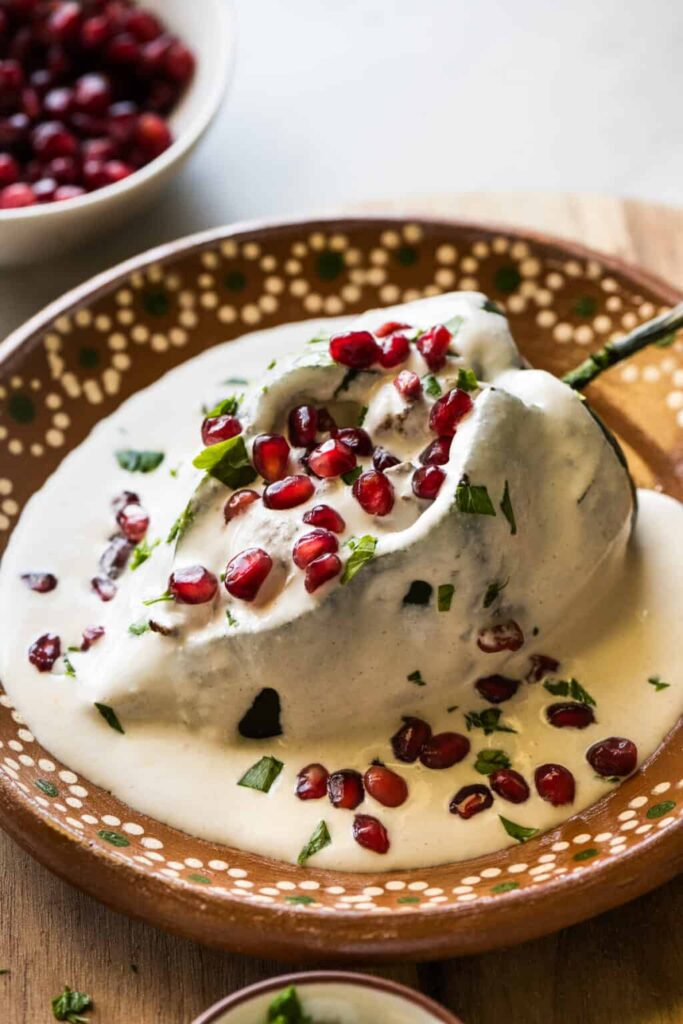
6) Chiles en Nogada
Chiles en Nogada is a classic Mexican dish known for its vibrant colors and rich flavors. You will need poblano peppers, ground meat, and a variety of fruits like apples and peaches.
First, roast and peel the poblano peppers. This step helps to remove the tough skin and brings out the pepper’s flavor. Then, make a filling with ground meat, fruits, nuts, and spices.
Cook the meat in a pan until it is done, adding fruits and seasonings like cinnamon and sugar to enhance the taste. Each bite combines the savoriness of the meat with the sweetness of the fruits.
Next, prepare the nogada sauce using walnuts, milk or cream, and spices. Soak the walnuts briefly to remove their skin, then blend them into a smooth sauce. This creamy, nutty sauce is a key feature of Chiles en Nogada.
Stuff the roasted peppers with the meat mixture and drizzle with nogada sauce. Garnish with pomegranate seeds and parsley for a festive touch. This dish not only tastes amazing but also looks beautiful.
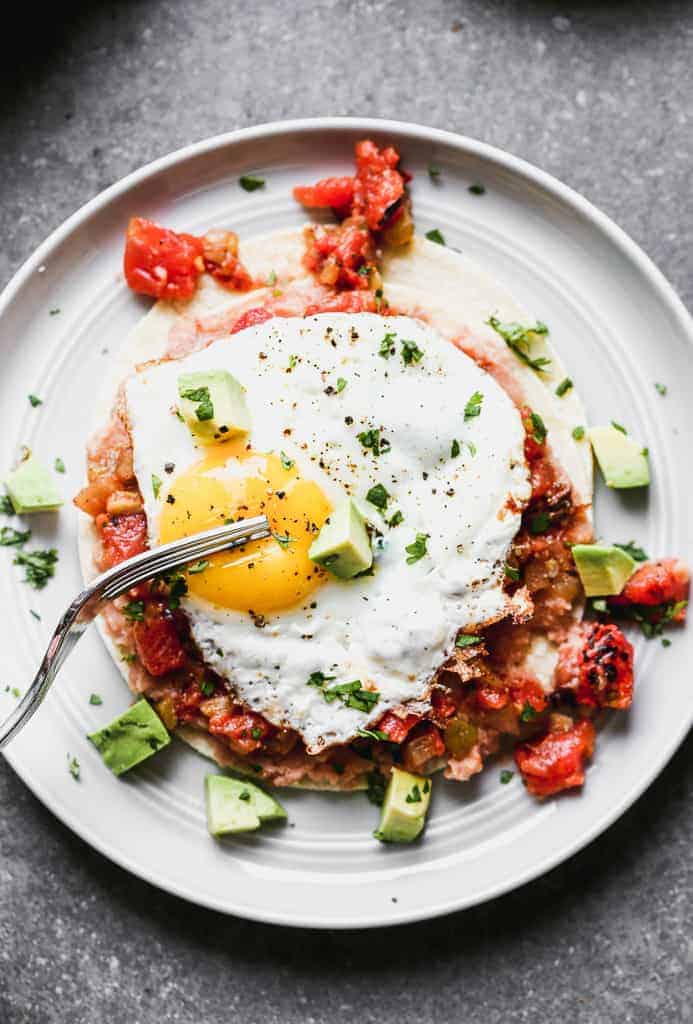
7) Huevos Rancheros
Huevos Rancheros is a classic Mexican breakfast dish. You start with tortillas, refried beans, salsa, and eggs. The salsa can be homemade or store-bought.
First, heat up your refried beans. Spread a layer over a tortilla.
Next, heat some vegetable oil in a pan. Crack your eggs into the pan and cook them to your preferred doneness.
While the eggs are cooking, you can prepare the salsa. Fry the salsa for a few minutes, then let it simmer until it thickens.
Once the eggs are done, place them on top of the tortillas with beans. Spoon some salsa over the eggs.
For an extra touch, sprinkle some fresh cilantro on top. Your Huevos Rancheros is ready! Enjoy this flavorful and hearty breakfast.
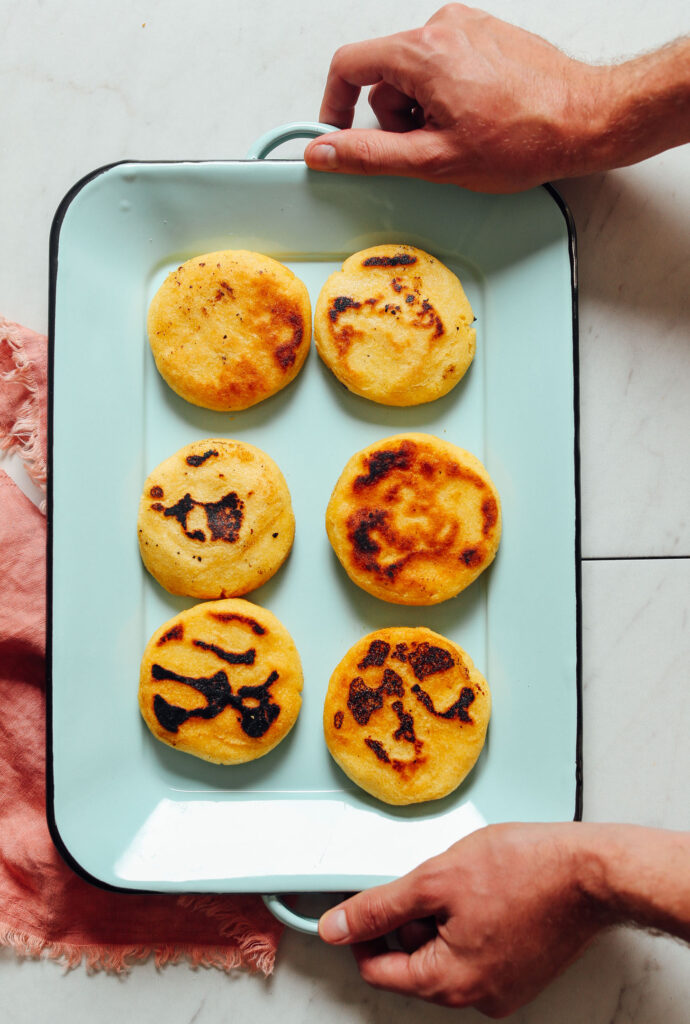
8) Arepas
Arepas are delicious cornmeal cakes popular in Latin American cuisine, especially in Venezuela and Colombia. They are versatile and can be enjoyed in many ways, such as for breakfast, lunch, or dinner.
To make arepas, you start by mixing cornmeal, warm water, and salt. Stir until a soft, moist dough forms. Let the dough rest for a few minutes so the cornmeal fully absorbs the water.
Once the dough is ready, form it into small, round patties. Heat a skillet over medium heat and add a little oil. Cook the arepas for about 4-5 minutes on each side until they are golden brown.
You can also bake the arepas in the oven. Preheat your oven to 350 degrees Fahrenheit (176 degrees Celsius) and bake them until they are cooked through. This method gives the arepas a slightly different texture.
After cooking, you can slice the arepas halfway through horizontally to create a pocket. Fill them with your favorite ingredients like cheese, meat, or avocado. Arepas are perfect for any meal and can be customized with a variety of fillings to suit your taste.
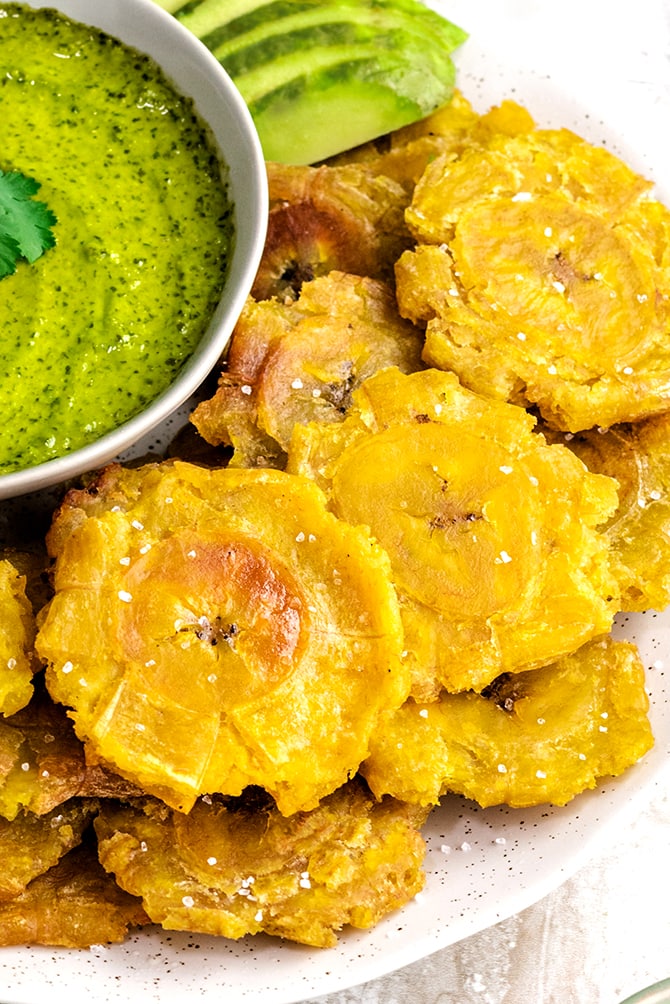
9) Tostones
Tostones are a popular dish made from green plantains. You start by peeling the plantains. Use a knife to cut a slit along the length to remove the peel easily. Once the peel is off, slice the plantains into one-inch rounds.
Heat some oil in a pan. Fry the plantain slices until they start to soften and get a light golden color. This usually takes about 2 to 3 minutes on each side.
Take the plantains out of the oil and place them on a paper towel. Use a flat object like the bottom of a cup to press each slice until it’s about half its original size.
Put the flattened plantains back into the hot oil. Fry them again until they are crispy and golden brown. This second fry should take about 2 minutes per side.
For extra flavor, you might choose to soak the plantain slices in a mixture of water, lime juice, and salt before the second fry. Serve your tostones hot with a sprinkle of salt یا a dipping sauce.
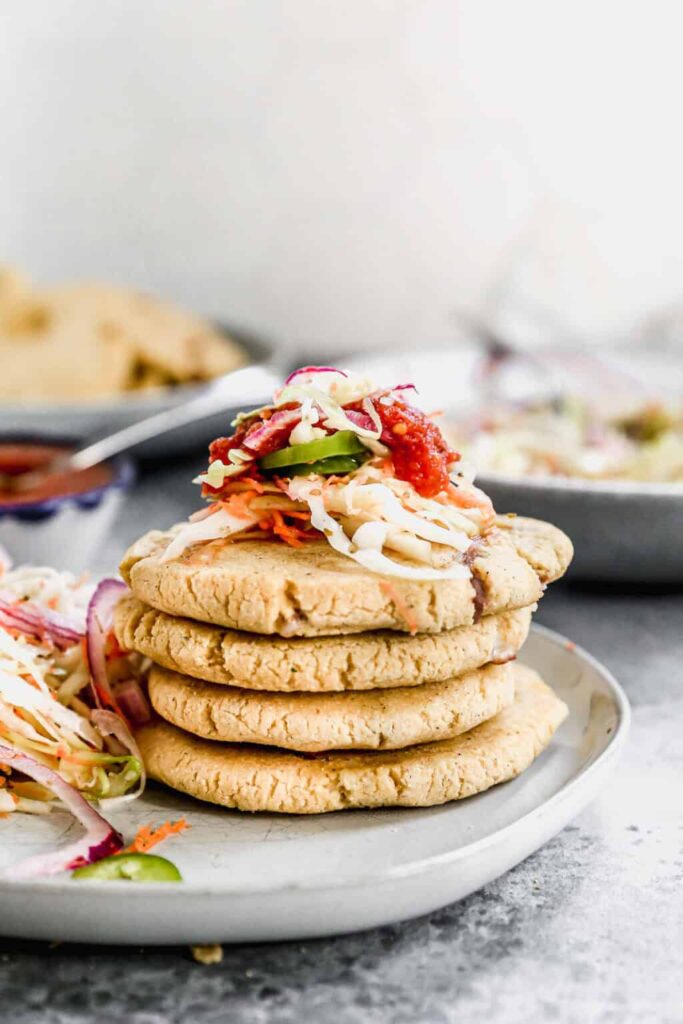
10) Pupusas
Pupusas are a delicious traditional dish from El Salvador. They are corn tortillas stuffed with a variety of fillings.
To make pupusas, you’ll start with masa harina, a type of corn flour, mixed with water. Form the dough into small balls and flatten them into circles.
The filling can be cheese, refried beans, pork, or a combination. Place the filling in the center of the dough circle and fold the edges up, pinching them closed.
Gently flatten the dough back into a circle. Be careful not to let the filling escape.
Cook the pupusas on a hot, dry griddle or skillet for about 2-4 minutes on each side. They should be golden and slightly crispy.
Serve your pupusas immediately. They are often topped with curtido, a tangy cabbage slaw, and salsa roja, a tasty red sauce. Both of these toppings add flavor and freshness.
If you want to make a large batch, you can freeze the pupusas before cooking. Just place them in an airtight container or freezer-safe bag. To cook, simply place them on a skillet straight from the freezer.
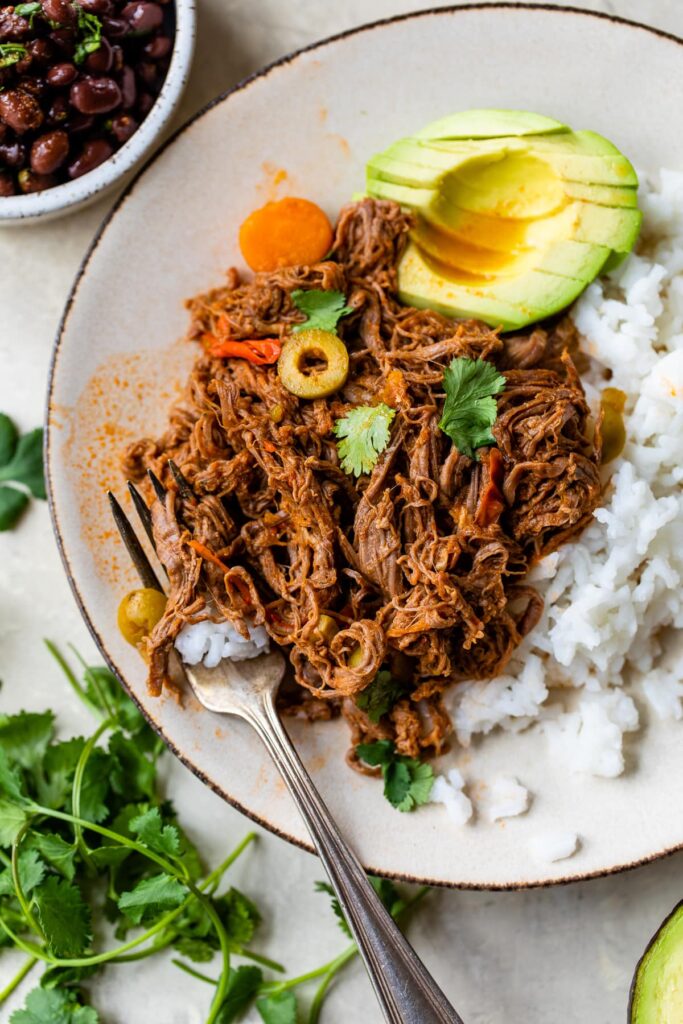
11) Ropa Vieja
Ropa Vieja is a traditional dish known for its rich flavors. It’s originally from the Canary Islands and became popular in Latin American countries, especially Cuba and Puerto Rico.
You start by searing flank steak until it’s browned on all sides. This step locks in the flavors. Transfer the steak to a slow cooker or pot.
Next, add beef broth and tomato sauce to the pot. Include tomato paste, bell pepper, onion, garlic, and cumin. Stir everything until well combined. Let it simmer so the meat absorbs all the flavors.
Simmering the beef for about 1.5 hours ensures it’s tender and easy to shred. When it’s done, use two forks to pull the meat into long, thin shreds. Mixing the beef back into the pot with the vegetables and cooking liquid completes the dish.
Serve Ropa Vieja with rice or warm tortillas. Garnish with fresh cilantro or lime wedges for added zest. Enjoy the hearty and fulfilling taste of this iconic Latin dish.
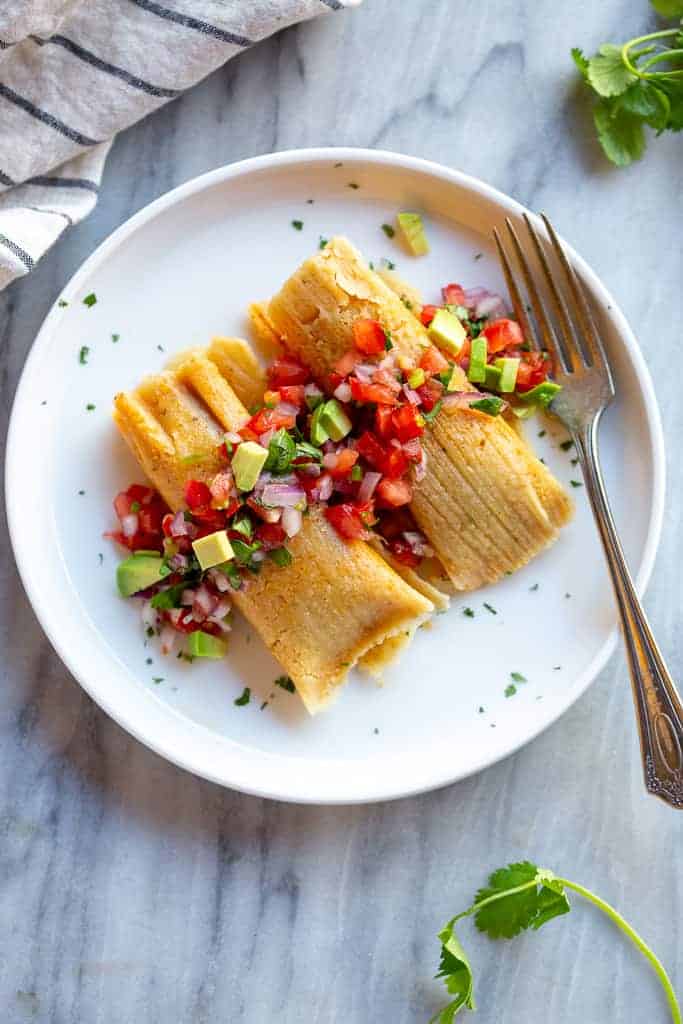
12) Tamal
Tamales are a beloved dish in Latin cuisine. They are made with a dough called masa, which is steamed in a corn husk. This masa dough is made from masa harina, a special corn flour.
To prepare tamales, you need to soak corn husks in hot water until they soften. Then, you prepare the fillings. Popular fillings include pork, chicken, beef, and even vegetables.
Once your fillings and masa are ready, spread a small amount of masa dough onto each corn husk. Add your filling in the center, then fold the husk to enclose the filling.
Stand the tamales upright in a steamer, with the open ends facing up. Steam them for about 60 to 90 minutes. Check the water level occasionally to ensure they don’t dry out.
When done, tamales should easily separate from the husks. Let them rest for a bit in the steamer to firm up before serving. Serve them hot, often with a side of salsa or beans.
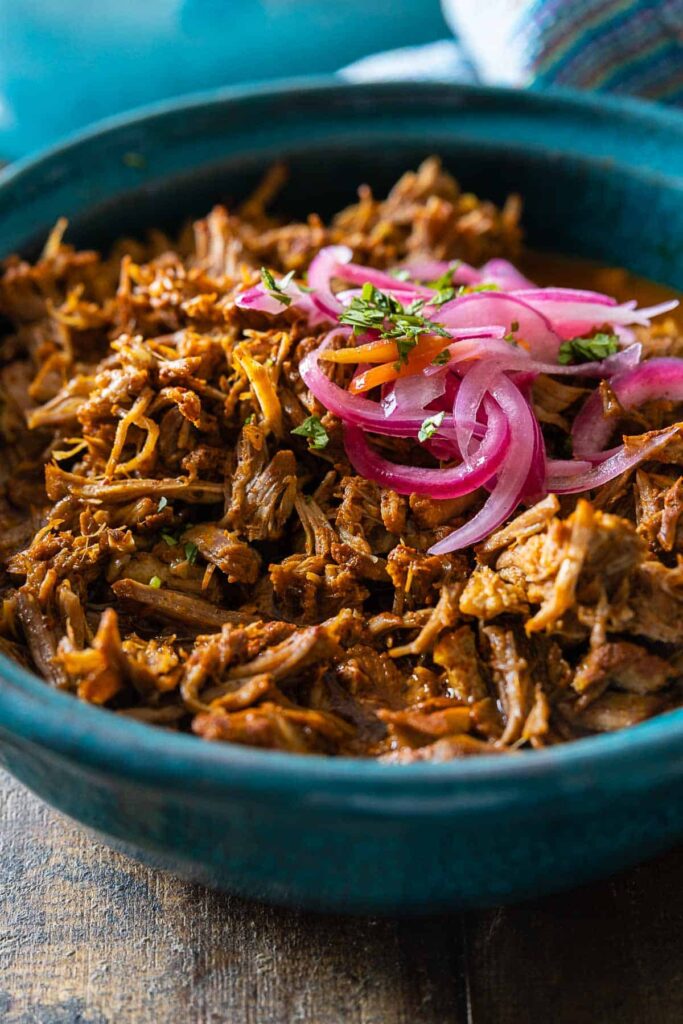
13) Cochinita Pibil
Cochinita Pibil is a flavorful dish from the Yucatán region of Mexico. It uses pork, marinated in a blend of achiote paste, citrus juices, and spices. The marinated pork is then wrapped in banana leaves and slow-cooked.
You start by combining achiote paste with bitter-orange juice, vinegar, and various spices like oregano, cloves, and cumin. Blend these ingredients until smooth to create the marinade.
Cut the pork into medium-sized chunks and place it in a non-reactive container. Pour the marinade over the pork, ensuring all pieces are well-coated. Cover the container and refrigerate for at least 6 hours.
When you’re ready to cook, line a steaming rack or baking dish with banana leaves. Place the marinated meat on top and cover it with more banana leaves. If using a pressure cooker, cook under high pressure for about an hour. If using an oven, slow-cook at 325°F for 3-4 hours.
The result is tender, flavorful pork that’s perfect for tacos or served with rice. Cochinita Pibil’s unique taste comes from the achiote and citrus marinade, giving it a distinctive bright color and tangy flavor.
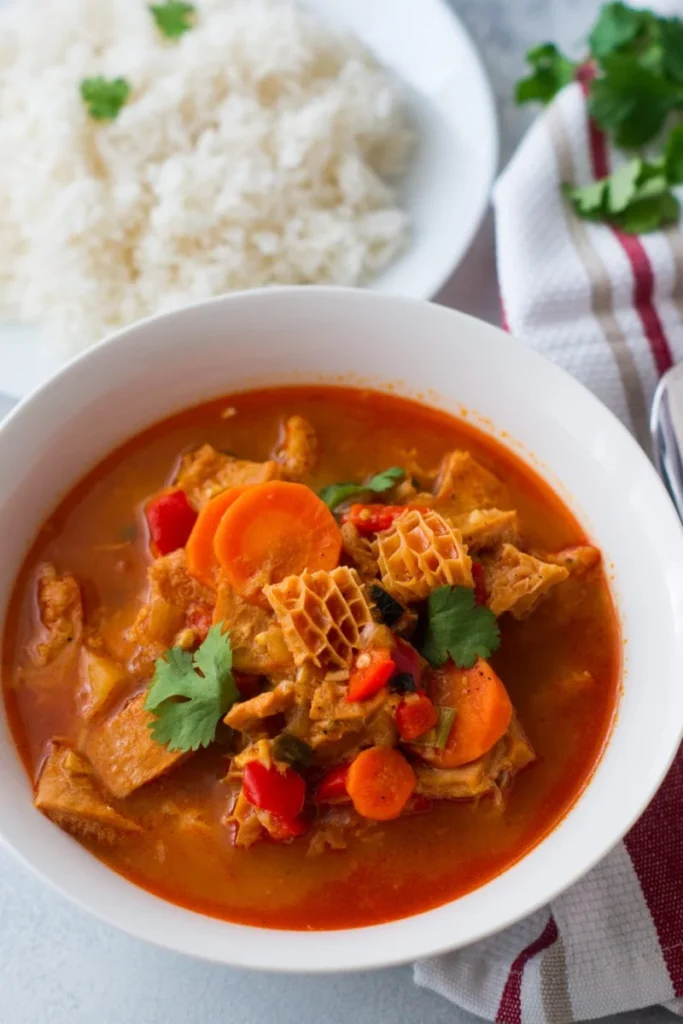
14) Mondongo
Mondongo is a traditional Latin American tripe stew. It’s enjoyed in countries like Mexico, Dominican Republic, Puerto Rico, and Colombia. Each country has its own unique way of preparing it, but the base ingredients are often similar.
In general, the main ingredient is beef tripe. You clean it thoroughly and cook it until tender. This can take anywhere from an hour to two hours, depending on the recipe and cooking method.
You might also add vegetables like potatoes, carrots, and peppers. Spices and seasonings such as garlic, onion, and various herbs are usually included to enhance the flavor.
The broth often includes beef or chicken stock. Some variations might use a mix of both. Lime juice is a common addition, giving the dish a slight tanginess.
Mondongo can be served as a hearty meal on its own or with sides like rice or bread. It’s a dish that brings warmth and comfort, making it a popular choice for family gatherings and special occasions.
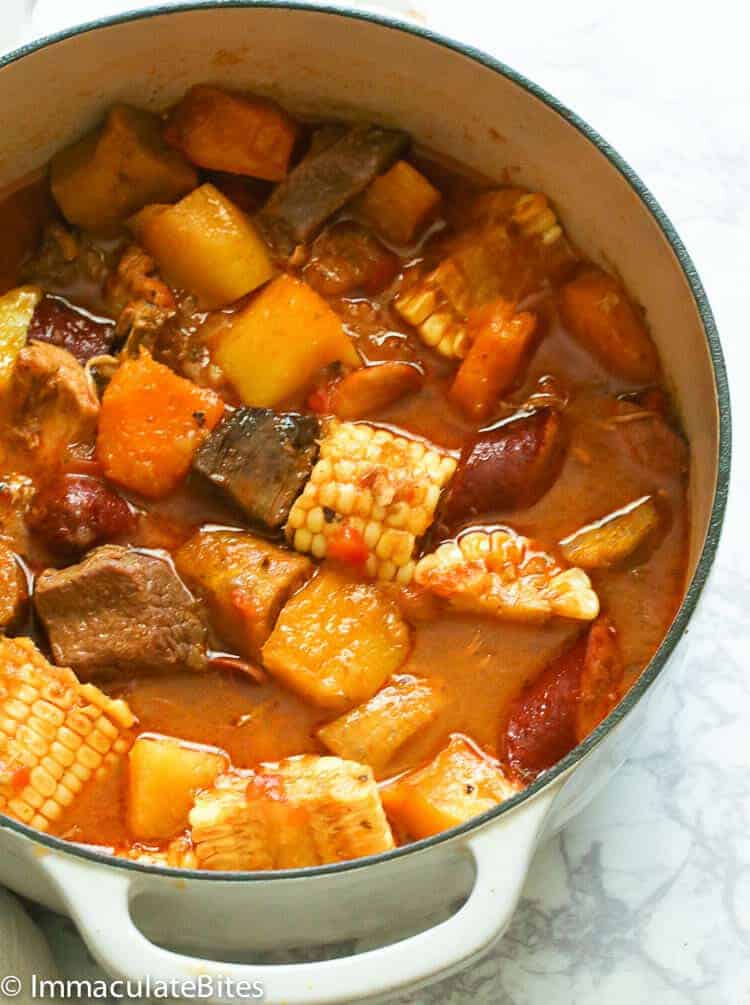
15) Sancocho
Sancocho is a rich, hearty stew popular in many Latin American countries. It’s especially beloved in Puerto Rico and the Dominican Republic.
To begin, you’ll need a mix of meats. Beef, pork, and chicken are commonly used. Marinate the meats with lemon juice, onions, mashed garlic, oil, and vinegar.
Heat oil in a large pot and brown the meat on all sides. This initial searing locks in flavor.
Then, add vegetables like potatoes, yuca, plantains, calabaza, and corn. These starchy vegetables give the stew its thick, comforting texture. Cover the ingredients with chicken stock or beef broth.
Season the stew with sofrito, sazón, adobo, and bay leaves. Each spice and herb adds depth to the flavor.
Simmer the stew on low heat until the vegetables are tender and the meat is cooked through. This typically takes about 30 to 40 minutes.
Before serving, skim any excess fat from the top. Sancocho is best enjoyed piping hot, offering a warm, filling meal that’s perfect for any occasion.
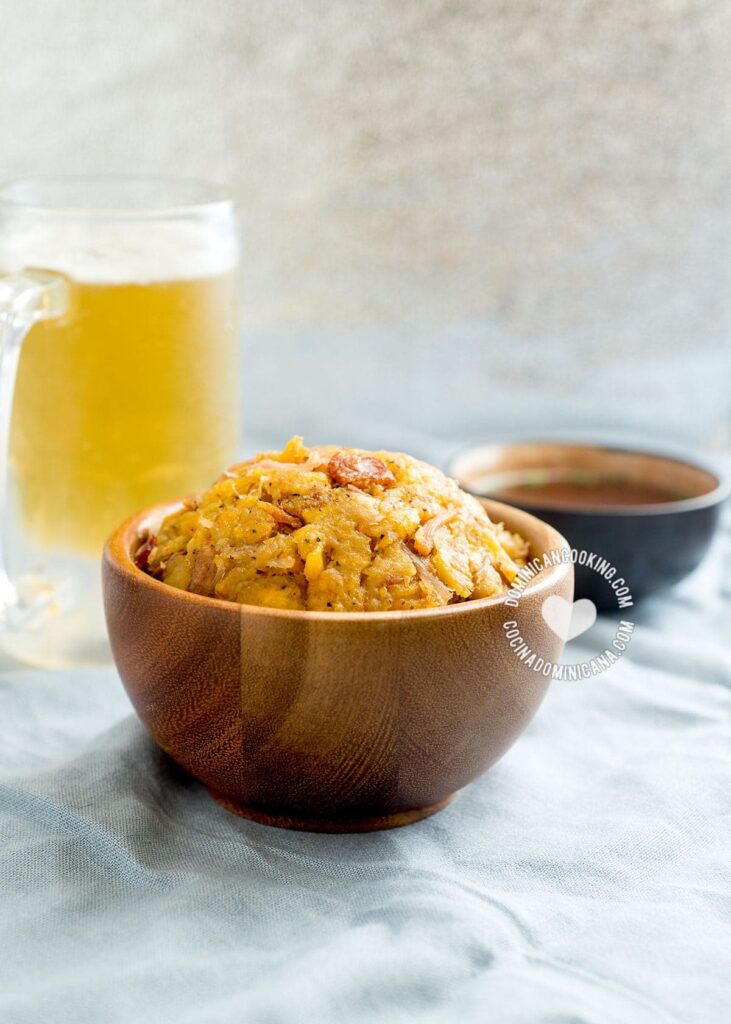
16) Mofongo
Mofongo is a traditional Puerto Rican dish made from fried green plantains. You start by peeling and slicing the plantains into rounds. Next, fry them in hot oil until they are golden and tender.
Once the plantains are fried, you mash them with garlic using a mortar and pestle. This creates a flavorful mixture. To this, you can add pork cracklings, which add both flavor and texture.
Many recipes include other seasonings like salt, pepper, and sometimes cumin. Some versions use a little beef stock to keep the mixture moist. You shape the mashed plantains into balls or mounds.
Mofongo is often served with a garlic sauce or broth. This sauce can include ingredients like olive oil, crushed garlic, and a bit of fresh orange juice. Drizzle it over the mofongo to enhance its taste.
Enjoy mofongo as a main dish or a side. It pairs well with meats, seafood, or a fresh salad.
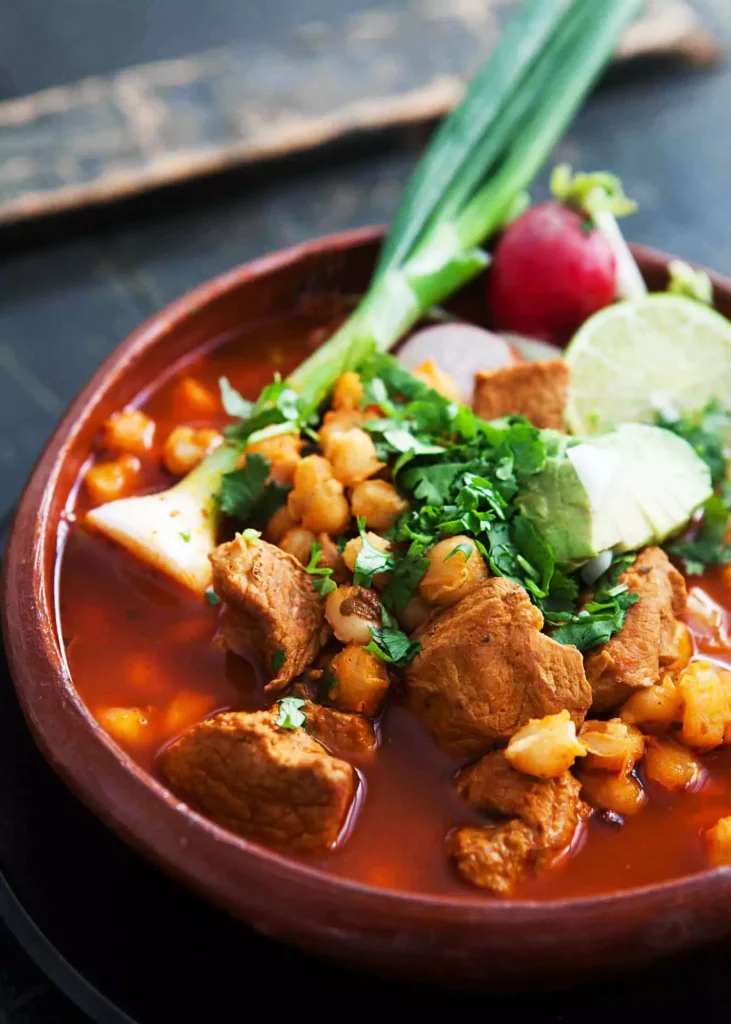
17) Pozole Rojo
Pozole Rojo, also known as Red Posole, is a traditional Mexican stew made with pork and hominy. Originating from indigenous Mexican cuisine, this dish is rich and full of flavor.
Start by browning pork in a large pot. This adds depth to the flavor. Remove the pork once browned.
In the same pot, cook onions until they’re lightly browned. Add garlic and cumin, cooking for another minute to release their aromas.
Prepare guajillo chilies by removing seeds and stems. Boil them until soft, then blend them into a smooth puree.
Return the browned pork to the pot. Add the chile puree, along with oregano, bay leaves, and broth. Stir well.
Add hominy to the mixture and bring it to a gentle boil. Let it simmer until the flavors meld together.
Serve Pozole Rojo hot, topped with fresh ingredients like shredded lettuce, radish slices, and lime wedges. Enjoy this comforting, hearty stew with your favorite toppings.
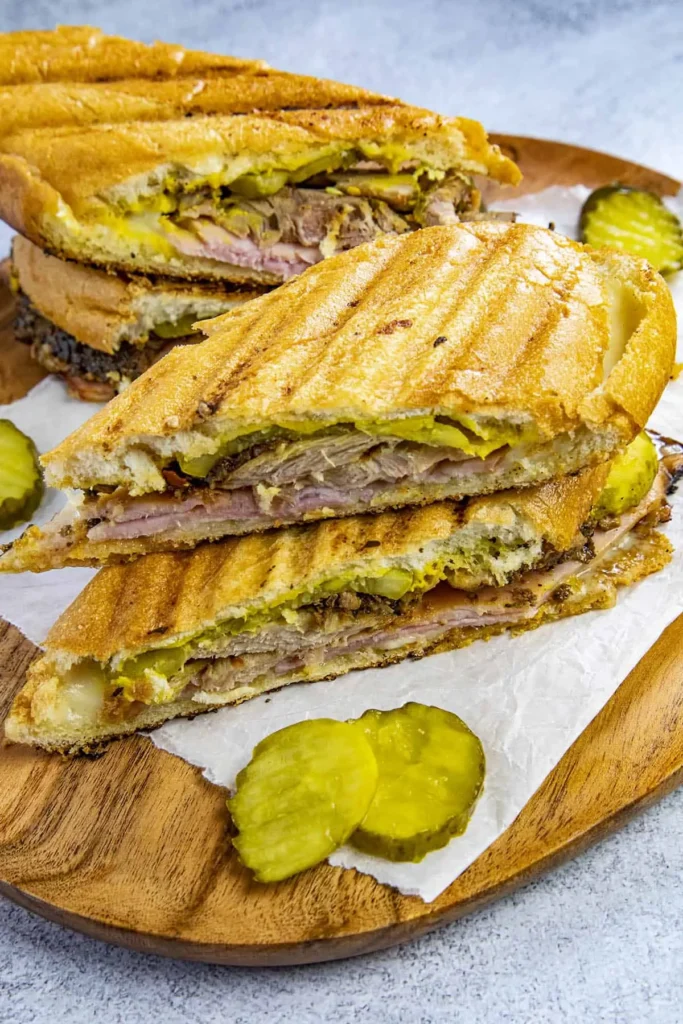
18) Cuban Sandwich
The Cuban Sandwich, or Cubano, is a delicious Latin classic. It features layers of Swiss cheese, ham, roast pork, and pickles between slices of Cuban bread. Each bite combines savory, tangy, and crunchy flavors for a satisfying meal.
To prepare, first, preheat a panini press or skillet. Spread mustard on both slices of bread. Lay Swiss cheese, pickles, ham, and roast pork in layers, then top with more Swiss cheese. Place the other slice of bread on top.
For a crispy finish, spread butter on the outside of the bread. Press the sandwich on the panini press or cook it in the skillet until golden brown and the cheese melts.
This sandwich is great for lunch or a quick dinner. Serve it with plantain chips or a side salad for a complete meal.

19) Flan
Flan is a popular dessert in many Latin American countries. It’s known for its smooth, creamy texture and rich caramel flavor. This dessert is made with simple ingredients like eggs, milk, sugar, and vanilla.
Start by making the caramel. In a saucepan, mix sugar and water and heat until it turns golden brown. Be careful not to burn it.
Pour the caramel into a mold and swirl it around to coat the bottom. Allow it to harden.
In a bowl, whisk eggs, sweetened condensed milk, evaporated milk, and vanilla. Pour this mixture over the hardened caramel in the mold.
Place the mold in a water bath. Fill a larger pan with hot water, about halfway up the sides of the flan mold. This will help the flan cook evenly.
Bake the flan in a preheated oven at 350°F for about 50 minutes. Check if it’s done by inserting a knife in the center; it should come out clean.
Once baked, let the flan cool to room temperature. Then, refrigerate it for at least two hours before serving.
To serve, carefully flip the mold onto a plate. The caramel will create a delicious sauce over the flan. Enjoy this classic, creamy dessert!
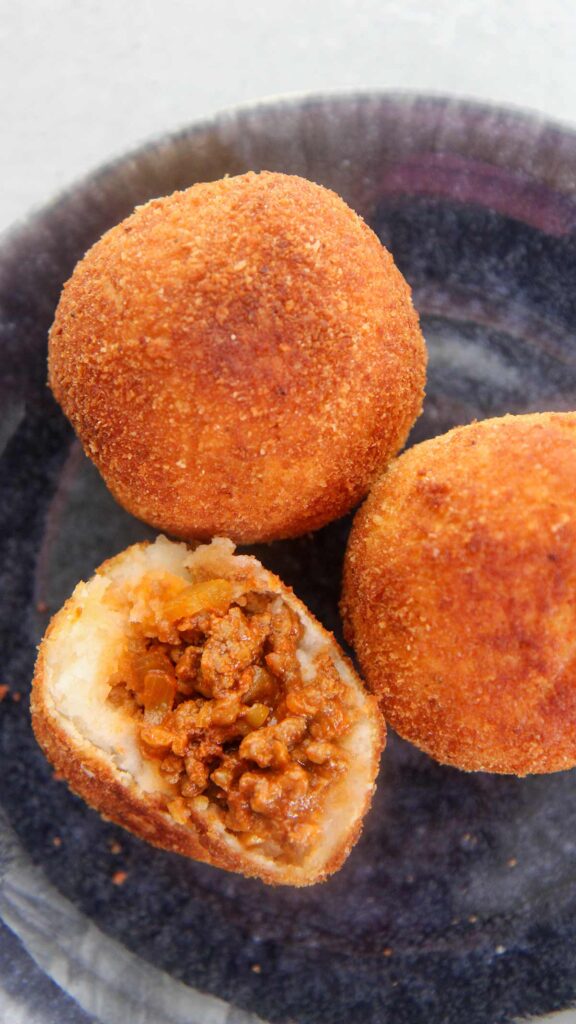
20) Relleno de Papa
Relleno de Papa, or Puerto Rican stuffed potatoes, is a delicious and comforting dish. You start by peeling and cutting potatoes into chunks. Boil them until they are tender. Once done, drain and mash them until smooth. Let them cool completely.
For the filling, you typically use picadillo, a savory mixture of ground beef, onions, garlic, olives, and spices. Form balls of mashed potatoes and create a hollow center. Fill each potato ball with the picadillo mixture.
After filling, reshape the potatoes into balls, making sure the filling is completely covered. Dust them lightly with cornstarch. Heat a pot with oil to about 370°F. Fry the potato balls until they are golden brown and crispy on the outside. Be careful as hot oil can splatter.
Drain the cooked Relleno de Papa on paper towels. You can enjoy them as a snack or part of a meal. These stuffed potatoes have a crunchy exterior and a flavorful, moist interior. They are a great way to bring a taste of Puerto Rican cuisine to your kitchen.
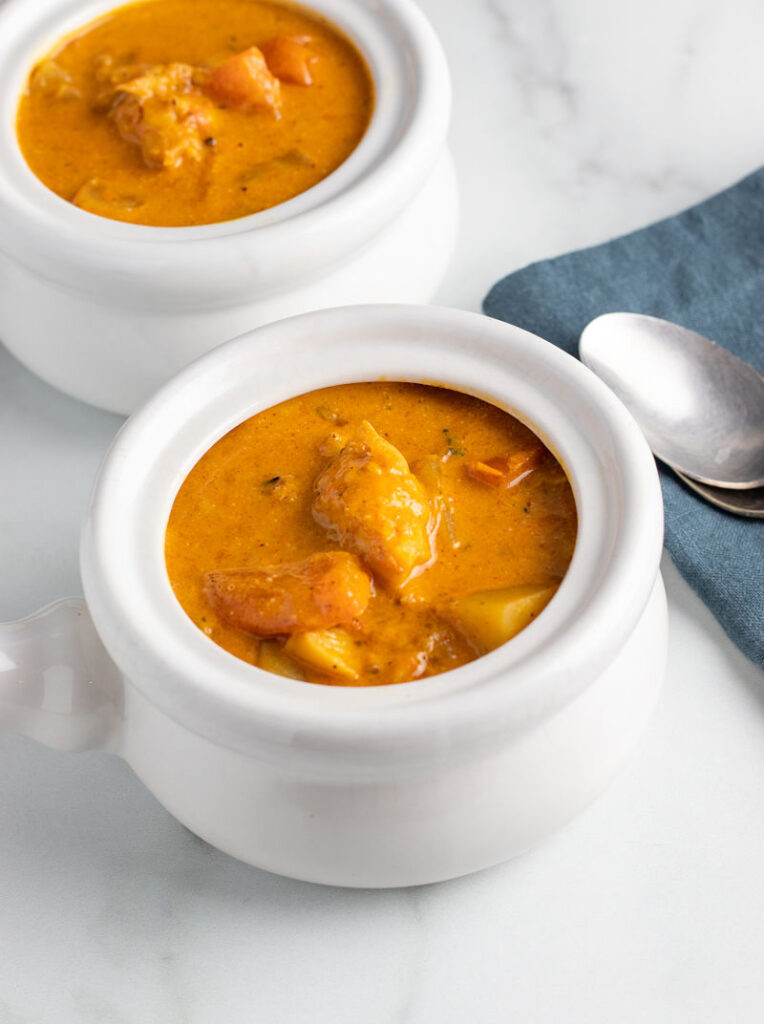
21) Moqueca
Moqueca is a traditional Brazilian fish stew known for its rich flavors and vibrant colors. It features firm white fish like halibut, swordfish, or cod. The fish is often marinated in lime juice, oil, salt, and pepper. This marination enhances the taste and ensures the fish is tender.
In a large skillet or Dutch oven, you heat oil and cook onions, garlic, and bell peppers until they soften. Adding tomatoes, coconut milk, and seafood stock gives the stew its creamy base. Dendê oil, a type of palm oil, is also a key ingredient, contributing a unique flavor.
The fish is then gently added to the simmering sauce, allowing it to cook through without breaking apart. You can use other seafood too, such as shrimp or calamari, for added variety.
Moqueca is typically served with rice and sometimes accompanied by toasted cassava flour called farofa. The dish is a beautiful blend of tropical flavors and aromas, showcasing the rich culinary heritage of Brazil. Enjoying Moqueca is like taking a trip through the coastal regions of Brazil without leaving your kitchen.
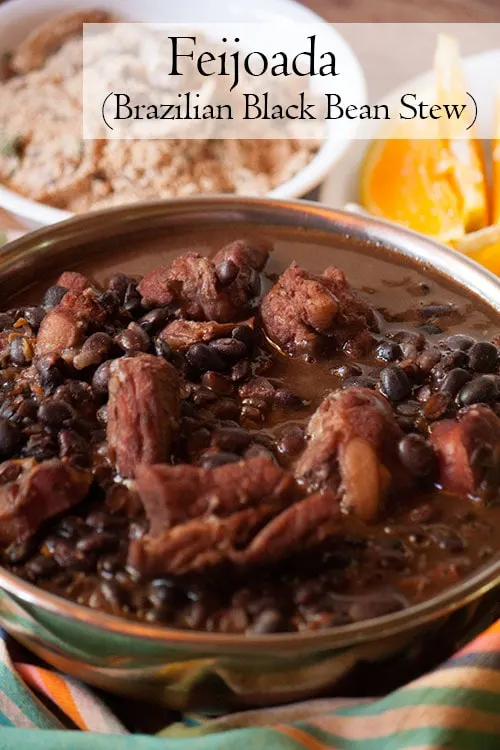
22) Feijoada
Feijoada is a traditional Brazilian black bean stew often enjoyed as a hearty meal. This dish features black beans simmered with a variety of meats like pork, beef, and sausages. Each ingredient adds a rich flavor to the stew.
To start, soak the beans overnight in cold water. This helps soften them and reduce cooking time. Also, soak the salted meats and sausages in water, changing the water a few times to remove excess salt.
When you’re ready to cook, sauté onions and garlic in oil until caramelized. Add the soaked beans, meats, bay leaves, black pepper, and enough water to cover everything. Bring it to a boil, then simmer on low heat for around two hours.
Check the beans often to make sure they are soft and cooked through. If the stew is too liquidy, cook it uncovered for 20 minutes to thicken. Serve Feijoada with white rice, collard greens, and orange slices. These sides add balance to the rich flavors of the stew.
Feijoada is often enjoyed during family gatherings or special celebrations. It’s a dish that carries both tradition and comfort, making it a favorite in Brazilian cuisine.
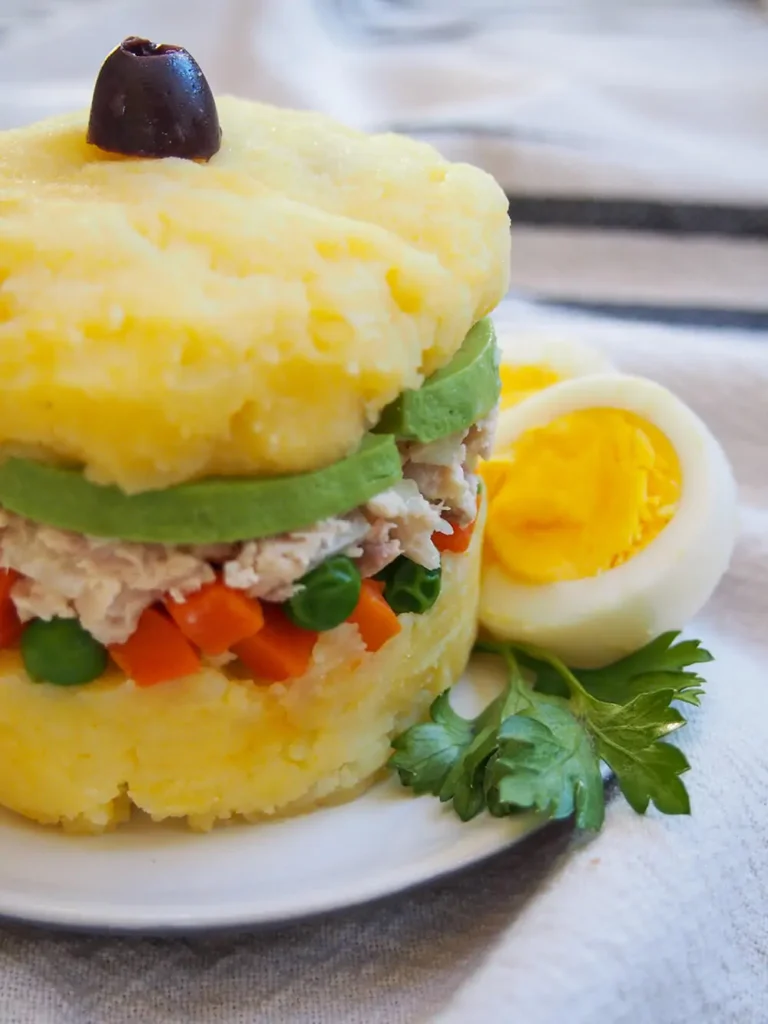
23) Causa Rellena
Causa Rellena is a popular Peruvian dish made with potatoes and various fillings. The base is a smooth, mashed potato mixed with lime juice, olive oil, and ají amarillo paste.
You begin by boiling potatoes until tender. After draining them, mash them with a potato ricer to achieve a smooth texture. Add lime juice, oil, and ají amarillo paste for flavor.
The filling can vary, but a common choice is a mixture of chicken, mayonnaise, and vegetables. You layer the potato mix and the filling, alternating them in a mold.
Refrigerate the layered dish for a few hours to set. When it’s time to serve, carefully unmold the Causa Rellena onto a plate.
Garnish with traditional toppings like hardboiled eggs, black olives, and avocado slices. Serve chilled for a refreshing and satisfying appetizer or side dish. This recipe is perfect for showcasing the vibrant flavors of Peru.
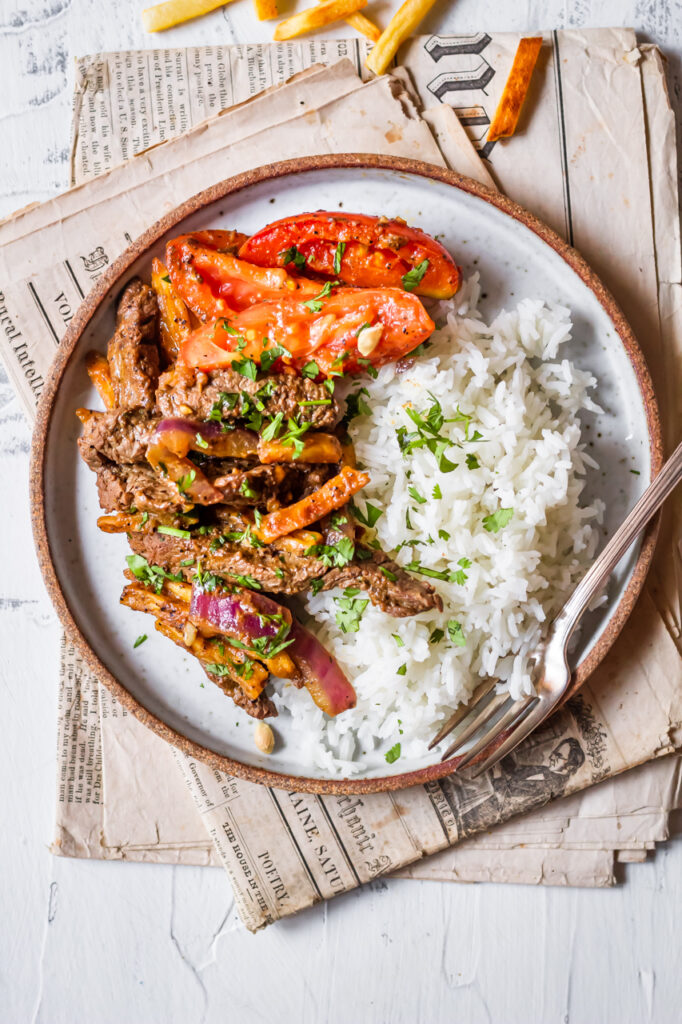
24) Lomo Saltado
Lomo Saltado is a popular Peruvian dish known for its flavorful blend of ingredients. It’s a stir-fry that combines beef, vegetables, and fries, typically served with rice.
To make Lomo Saltado, start by frying potato slices until golden brown. Set them aside.
Marinate strips of beef with cumin, salt, vinegar, olive oil, black pepper, and soy sauce. Let it sit for about 10 minutes.
In a hot skillet, add oil and sear the beef until it’s browned on both sides. Remove the beef and set it aside.
In the same skillet, add onions and cook until they turn golden around the edges. Stir and sauté for another minute or two.
Next, add tomatoes and cook until they soften slightly. Combine everything back in the skillet, including the beef and fried potatoes. Toss in some scallions and cilantro.
Serve Lomo Saltado with a side of freshly steamed rice. The combination of crispy fries, tender beef, and flavorful veggies makes for a satisfying meal.
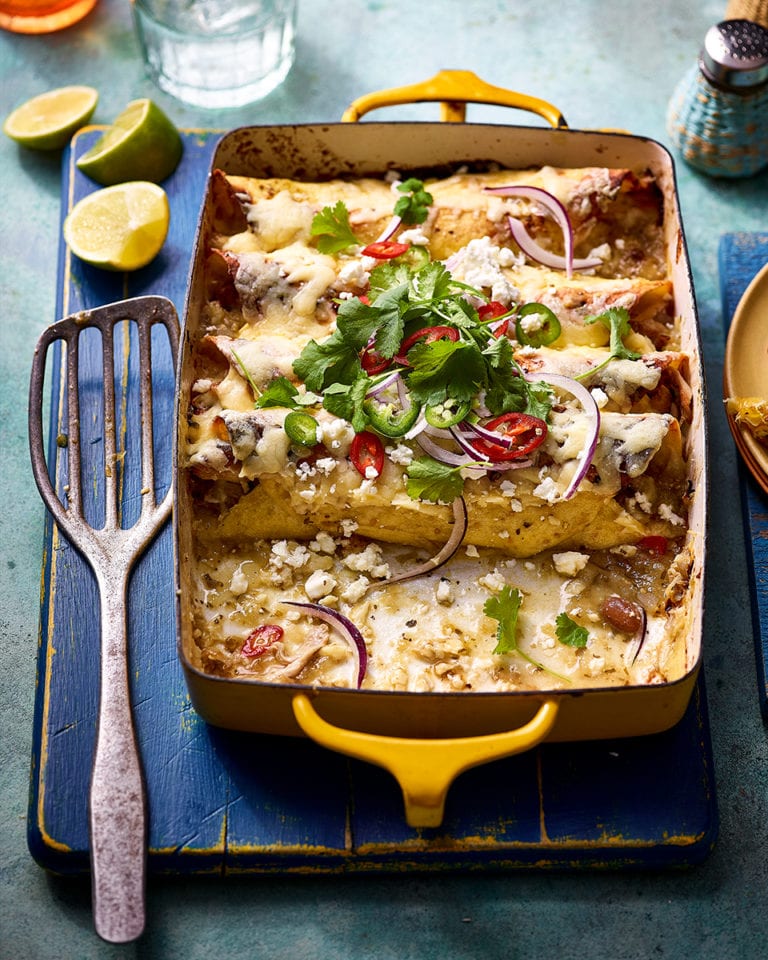
25) Enchiladas Verdes
Enchiladas Verdes are a tasty Mexican dish that’s perfect for any meal. You start by preparing the green sauce, which includes tomatillos, garlic, onion, and jalapenos. Boil these ingredients for 5-7 minutes, then blend them with cilantro and chicken stock until smooth.
Heat a little olive oil in a frying pan. Add the blended sauce and cook for 3-5 minutes, seasoning with salt and pepper to taste. Heat your tortillas briefly in a skillet with some oil until they’re warmed through.
Fill each tortilla with a mixture of cooked chicken, then roll them up and place seam side down in a baking dish. Pour your green sauce over the top of the enchiladas.
Top with cheese and bake in a preheated oven until the cheese is melted and bubbly. Serve hot and enjoy your delicious homemade Enchiladas Verdes with your favorite sides like rice and beans.
Health Benefits of Latin Food
Latin food offers a variety of health benefits, particularly when focusing on its nutritional value, use of fresh ingredients, and its potential to support a balanced diet.
Nutritional Value
Latin cuisine often includes nutrient-dense foods. Beans and legumes are staples in many dishes, providing excellent sources of protein, fiber, vitamins, and minerals. These nutrients are crucial for maintaining muscle, digestive health, and overall energy levels.
Avocados, another common ingredient, are rich in healthy fats, vitamins C, E, and K, and potassium. These nutrients can support heart health and help regulate blood pressure.
Tomatoes and peppers used in salsas and sauces are high in vitamins A, C, and antioxidants, which can strengthen the immune system and protect cells from damage.
Use of Fresh Ingredients
Latin recipes frequently call for fresh vegetables and herbs. Fresh cilantro, parsley, and lime juice are common, providing vibrant flavors along with essential vitamins and antioxidants. This freshness enhances taste without adding unhealthy fats or excessive sodium.
Vegetables like tomatoes, onions, and peppers are often used raw in dishes like salsas, ensuring that the nutrients remain intact and potent. This focus on fresh ingredients helps retain the maximum nutritional benefits.
Tropical fruits such as mangoes, papayas, and pineapples are also popular, delivering vitamins, minerals, and natural sugars that can boost energy and improve overall health.
Balanced Diet
Many traditional Latin dishes are naturally balanced. Grilled meats, like chicken and fish, paired with whole grains such as rice and corn tortillas, provide a good mix of protein and complex carbohydrates. This combination can help maintain stable energy levels throughout the day.
Dishes like ceviche, which typically includes fresh fish marinated in citrus juice, paired with vegetables, create a meal that is low in saturated fat and high in nutrients. This makes it easier to follow a diet that supports weight management and heart health.
Fajitas and tacos often include a variety of colorful vegetables, lean meats, and wholesome grains, offering a delicious way to meet daily nutritional needs without overconsuming calories.
Cooking Tips and Techniques
Mastering Latin food requires knowing the essential spices and herbs, understanding key cooking methods, and focusing on presentation and garnishing for the best flavor and visual appeal.
Essential Spices and Herbs
In Latin cuisine, spices and herbs are crucial for authentic flavors. Cumin provides an earthy flavor and is a staple in many dishes like tacos and chilis. Oregano, particularly Mexican oregano, adds a citrusy note that pairs well with tomato-based sauces.
Cilantro offers a fresh, bright taste and is often used in salsas and garnishes. Páprika and chili powder give depth and heat to soups and stews. Annatto seeds are essential for a distinctively vibrant color and mild flavor in dishes like achiote chicken.
Bay leaves impart a subtle bitterness that’s great for slow-cooked dishes. Ensure you have a well-stocked spice rack to recreate the iconic flavors of Latin American cooking.
Cooking Methods
Latin cuisine employs various cooking methods that bring out unique tastes and textures. Slow cooking is a popular technique for achieving tender meats in dishes like ropa vieja. Grilling gives a smoky flavor to meats and vegetables, common in Argentinian barbecues.
Sautéing is often used to quickly cook ingredients like onions, garlic, and peppers, forming the base of many recipes. Braising combines dry and wet heat to tenderize meat, perfect for dishes like birria tacos.
Steam cooking is another method, especially for preparing tamales. Frying, whether shallow or deep, is used for foods like empanadas and churros. Each method contributes differently, and understanding when to use each is key.
Presentation and Garnishing
The presentation is essential in Latin cooking, enhancing both the eating experience and the dish’s appeal. Fresh vegetables and herbs not only add color but also enhance flavor. Chopped cilantro and lime wedges are common garnishes that add freshness and acidity to many dishes.
Sliced avocado and fresh radishes provide texture and visual contrast. Cotija cheese or queso fresco sprinkled on top adds a salty tang. For an elegant touch, use vibrant ingredients like pickled red onions and pomegranate seeds.
Consider the dish’s colors and textures when plating. Pairing bright and contrasting colors can elevate the overall presentation. Use simple garnishes wisely to make each meal look inviting and appetizing.
